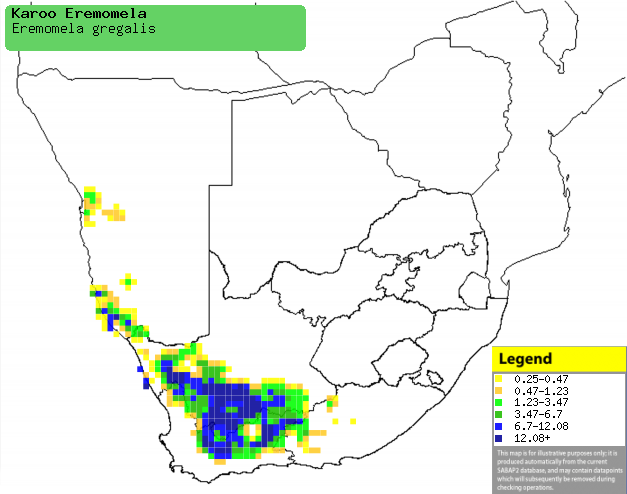|
Eremomela gregalis (Karoo
eremomela)
Groenbossanger [Afrikaans]; Karoo-eremomela [Dutch];
Érémomèle du Karroo [French]; Langschwanz-eremomela [German]; Eremomela
do Karoo [Portuguese]
Life
> Eukaryotes >
Opisthokonta
> Metazoa (animals) >
Bilateria >
Deuterostomia > Chordata >
Craniata > Vertebrata (vertebrates) > Gnathostomata (jawed
vertebrates) > Teleostomi (teleost fish) > Osteichthyes (bony fish) > Class:
Sarcopterygii (lobe-finned
fish) > Stegocephalia (terrestrial
vertebrates) > Tetrapoda
(four-legged vertebrates) > Reptiliomorpha > Amniota >
Reptilia (reptiles) >
Romeriida > Diapsida > Archosauromorpha > Archosauria >
Dinosauria
(dinosaurs) > Saurischia > Theropoda (bipedal predatory dinosaurs) >
Coelurosauria > Maniraptora > Aves
(birds) > Order: Passeriformes
> Family: Sylviidae > Genus: Eromomela
Distribution and habitat
Endemic to southern Africa, preferring arid and semi-arid
bush on flats and hillsides. It is fairly common, with the bulk of its of
population centered on the Karoo.
|
 |
|
Distribution of Karoo eremomela in southern
Africa, based on statistical smoothing of the records from first SA Bird
Atlas Project (©
Animal Demography unit, University of
Cape Town; smoothing by Birgit Erni and Francesca Little). Colours range
from dark blue (most common) through to yellow (least common).
See here for the latest distribution
from the SABAP2. |
Food
It mainly eats invertebrates, gleaning them from shrubs and
tree branches and occasionally plucking prey from the ground. The following food items have been recorded
in its diet:
Breeding
- It is a facultative cooperative breeder, with all group members helping
with the gathering of twigs, Old-Man's Beard (Galium tomentosum) and
dry grass for the nest. This consists of a thick walled cup lined with the
fluffy seeds of Karoo rosemaries (Eriocephalus) and typically placed
in a forked branch deep within a small bush.
- Egg-laying season is almost year-round, peaking from August-October.
- It lays 2-4 eggs, which are probably incubated by both sexes for at
least 11 days.
- Not much information is available about the chicks, other than that they
are fed by all members of the group.
Threats
Not threatened.
References
-
Hockey PAR, Dean WRJ and Ryan PG 2005. Roberts
- Birds of southern Africa, VIIth ed. The Trustees of the John Voelcker
Bird Book Fund, Cape Town.
|
